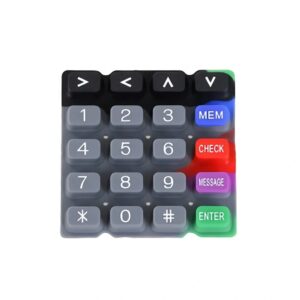Dear friends did you miss me, it’s already December, which means that Christmas is three weeks away. Are you guys happy? But for those of you who are reading this article you must have a need for keypads, do you want to customize some keypads with us before you go on vacation? And here are some notes on choosing a keypad, hope it will be helpful for you.
Keypads serve a vital function in facilitating user interaction with various devices and machinery. Functioning as interfaces, they empower users to control the associated devices. Keyboards typically comprise an array of keys, each capable of transmitting electrical signals to the device upon activation. Despite their shared objective of serving as interfaces, keypads exhibit considerable variability. Herein lies a set of guidelines to adhere to and pitfalls to avoid when selecting a keypad.
Consideration of Material is Essential:
The consideration of material is paramount in the keypad selection process. Keypads exhibit diverse compositions, ranging from rubber and plastic to those featuring stainless steel keycaps. In the case of silicone rubber keypads, they are characterized by the utilization of silicone rubber with integrated webbing. Upon key press, the silicone rubber webbing undergoes deformation, promptly restoring to its original configuration upon key release.
Ensure Alignment with Intended Application:
Various applications necessitate distinct types of keypads. When in the process of selecting a keypad, it is imperative to ensure its compatibility with the specific application or applications you have in mind. Whether the keypad is intended for deployment as a machine interface in a corporate setting or for purposes such as data entry or security access, the alignment with the intended application is crucial. Selecting a keypad tailored to the specific application requirements is essential for optimal functionality.

Ensure the Selection of Appropriate Circuitry It is essential to opt for a keypad equipped with the suitable circuit type. Keypads vary in their circuitry, with some featuring rigid printed circuit boards, while others employ flexible printed circuit boards. Additionally, certain keypads may incorporate a screen-printed circuit layer into their design. Careful consideration of the circuit type is paramount to align the keypad with specific operational requirements.
Prioritize Backlighting Integration:
Backlighting is a pivotal consideration in keypad selection. Beyond its aesthetic appeal, backlighting substantially elevates the performance and usability of keypads, particularly in low-light environments. Various technologies, including LED, light guides, and fiber optics, offer diverse backlighting options. These technologies operate by emitting light, penetrating the top layer of the keypad and enhancing visibility in low-light conditions. It is imperative to underscore the significance of backlighting integration when assessing keypad choices.
Avoid Selecting Keypads Excessive in Tactile Feedback:
While most keypads naturally generate tactile feedback through their webbing material to minimize errors, an overabundance of tactile feedback can have adverse effects. Increased tactile feedback correlates with a higher force requirement for keypresses, potentially impacting user experience. Careful consideration of the balance between tactile feedback and keypress force is crucial when choosing a keypad.
If you want to customize it, please don’t hesitate to let me know and I will talk to you about everything!Okay,thats all for today,see you:)